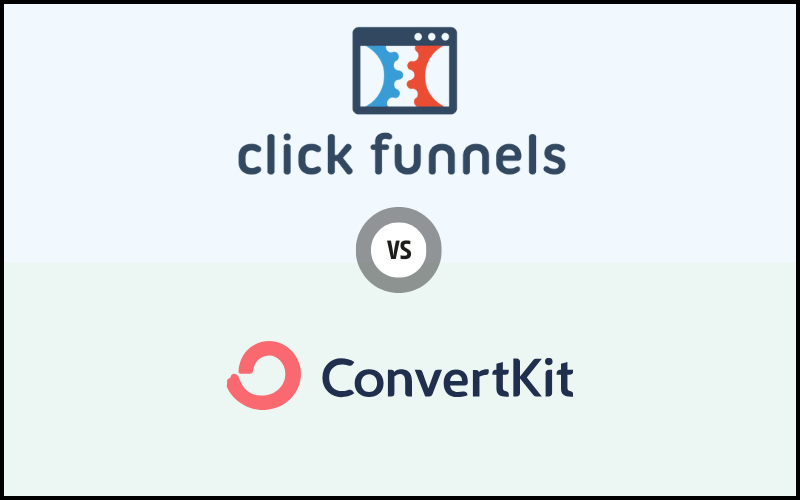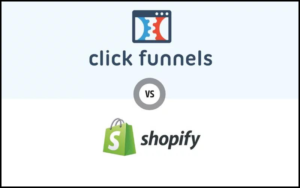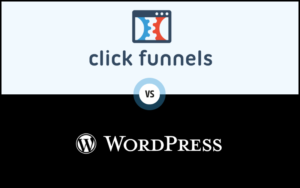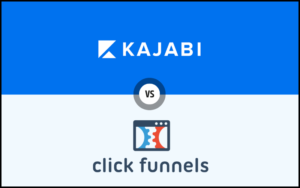When it comes to optimizing your digital marketing strategy, the “ClickFunnels vs ConvertKit” decision is a pivotal one that can significantly influence the trajectory of your online business. Both ClickFunnels and ConvertKit are powerful platforms that have transformed how businesses approach sales funnels and email marketing, respectively. This article aims to provide a detailed comparison of ClickFunnels and ConvertKit, helping you to understand which tool is best suited to your business needs.
Whether you’re a seasoned marketer, a business owner, or a content creator, the choice between ConvertKit vs ClickFunnels is more than just a comparison of features—it’s about finding the right fit for your marketing funnel strategy. Each platform has its unique strengths and weaknesses, and the right choice depends on a variety of factors, including ease of use, feature set, integration capabilities, and, of course, pricing.
In the following sections, we’ll dive deep into each platform, comparing them on multiple fronts to give you a clear picture of what they offer. We’ll explore everything from user interfaces and email marketing capabilities to customer support and overall performance. By the end of this article, you’ll have a comprehensive understanding of ClickFunnels and ConvertKit, enabling you to make an informed decision on which platform will best serve your digital marketing goals.
Table of Contents
Introduction to ClickFunnels and ConvertKit
In the dynamic world of digital marketing, two platforms have risen as prominent solutions for businesses and entrepreneurs: ClickFunnels and ConvertKit. This comprehensive comparison, focusing on “ClickFunnels vs ConvertKit,” aims to unravel the features, benefits, and suitability of each platform, guiding you to make an informed decision best suited to your business needs.
ClickFunnels at a Glance:
ClickFunnels is an all-in-one sales funnel builder designed to help businesses automate their sales process from start to finish. It’s a robust tool that enables users to create custom sales funnels for various purposes – from marketing and sales to webinars and subscription services. The platform excels in creating a seamless flow to convert visitors into leads and, eventually, paying customers.
Key Features of ClickFunnels:
- Drag-and-drop funnel builder
- A variety of customizable templates
- Integrated email marketing tools
- E-commerce capabilities
- Analytics and performance tracking
ConvertKit in Brief:
ConvertKit, on the other hand, is primarily an email marketing tool that’s tailored for creators such as bloggers, podcasters, and YouTubers. It focuses on helping users grow and engage their audience through effective email marketing strategies. ConvertKit makes it easy to create email campaigns, manage subscribers, and automate marketing workflows.
Key Features of ConvertKit:
- Intuitive email template editor
- Advanced email automation
- Subscriber segmentation and tagging
- Landing page builder
- Integration with various third-party applications

The Core Differences:
While both ClickFunnels and ConvertKit offer solutions to increase conversions and sales, their core functionalities cater to different aspects of the marketing funnel. ClickFunnels is more about creating an end-to-end sales funnel, whereas ConvertKit is focused on maximizing engagement and conversions through email marketing.
Ease of Use: ClickFunnels vs ConvertKit
When comparing “ConvertKit vs ClickFunnels,” understanding the ease of use of each platform is crucial for users, especially those who are new to digital marketing tools. This section delves into how user-friendly each platform is, considering its interface, navigation, and overall learning curve.
User Interface and Navigation of ClickFunnels:
ClickFunnels prides itself on a straightforward, drag-and-drop interface that simplifies the process of building sales funnels. Even without technical expertise, users can easily select templates, customize pages, and set up entire funnels. The dashboard is intuitive, with clear navigation that allows users to quickly find features and track their funnel’s performance.
Learning Curve for ClickFunnels Users:
Although ClickFunnels offers a wealth of features, its focus on simplicity means that new users can get up to speed relatively quickly. The platform provides ample educational resources, including tutorials and webinars, to assist users in understanding and utilizing its full capabilities.
User Interface and Navigation of ConvertKit:
ConvertKit, designed with simplicity in mind, boasts a clean and minimalistic interface. This design choice resonates well with its target audience of creators and bloggers, who often prefer straightforward tools. The platform allows easy creation of email campaigns, automation workflows, and landing pages without overwhelming the user with too many options.
Learning Curve for ConvertKit Users:
ConvertKit is generally easier for beginners, particularly those who are primarily focused on email marketing. The platform is less complex than ClickFunnels and provides a gentle learning curve. New users can benefit from ConvertKit’s extensive knowledge base, video tutorials, and live training sessions to quickly become proficient.
Conclusion:
In the “ClickFunnels vs ConvertKit” debate on ease of use, both platforms excel in providing user-friendly experiences but cater to different user needs. ClickFunnels is ideal for users who require a comprehensive tool for building sales funnels, while ConvertKit is more suited for those who want a simple yet effective email marketing platform.
Features and Functionality: ClickFunnels vs ConvertKit
When evaluating “ClickFunnels vs ConvertKit,” it’s essential to delve into the features and functionality each platform offers. This comparison aims to provide a clear understanding of how these tools can cater to your digital marketing needs.
Core Features of ClickFunnels:
ClickFunnels is designed as a comprehensive sales funnel builder. Its core features revolve around creating and optimizing various types of sales funnels.
- Sales Funnel Creation: Users can build funnels for webinars, sales, memberships, and more, using customizable templates.
- E-Commerce Integration: Facilitates product selling through integrated shopping carts and payment systems.
- A/B Testing: Offers the ability to test different versions of funnel pages to optimize conversions.
- Affiliate Management: Includes a built-in feature to manage and track affiliates.

Unique Features of ClickFunnels:
Beyond the basics, ClickFunnels provides unique features like ‘Backpack’, an affiliate program management tool, and ‘Actionetics’, an advanced marketing automation tool that combines funnels and email marketing.
Core Features of ConvertKit: ConvertKit, primarily an email marketing tool, focuses on features that enhance audience engagement and campaign management.
- Email Automation: Users can create automated email sequences for subscribers.
- Subscriber Tagging and Segmentation: Allows for targeted emails based on subscriber behavior.
- Customizable Sign-Up Forms and Landing Pages: Easy creation of forms and landing pages to attract and retain subscribers.
Unique Features of ConvertKit:
ConvertKit stands out with its emphasis on simplicity and effectiveness for creators. It offers advanced automation rules and the ability to easily integrate with other creator-focused platforms like Patreon or Shopify.
Conclusion
In the “ClickFunnels vs ConvertKit” comparison, the choice depends on your specific needs. ClickFunnels excels in building and optimizing sales funnels with a variety of tools suited for a full-fledged online business presence. On the other hand, ConvertKit is ideal for those who need a powerful, easy-to-use email marketing platform with excellent subscriber management features.
Email Marketing Capabilities: ClickFunnels vs ConvertKit
In the “ClickFunnels vs ConvertKit” comparison, understanding how each platform approaches email marketing is vital. Although both offer email marketing capabilities, they cater to different aspects and needs.
ClickFunnels and Email Marketing:
ClickFunnels integrates email marketing into its sales funnel process. It’s not primarily an email marketing tool, but it does provide features to support email-based communication within the sales funnel.
- Follow-Up Funnels: ClickFunnels allows you to send automated follow-up emails to nurture leads through the sales process.
- Broadcast Emails: Users can send one-time broadcast emails to their contact list for announcements or promotions.
- Integration with Third-Party Email Services: If you need more advanced email capabilities, ClickFunnels can integrate with popular email platforms like Mailchimp or ActiveCampaign.
ConvertKit and Email Marketing:
ConvertKit, on the other hand, is primarily an email marketing platform, offering a more robust and focused set of features for email campaigns.
- Advanced Email Automation: ConvertKit excels in creating complex email sequences based on user actions or engagement levels.
- Subscriber Segmentation: Highly effective tools for segmenting and tagging subscribers, allowing for personalized and targeted email campaigns.
- Customizable Email Templates: While keeping simplicity at its core, ConvertKit offers a range of customizable templates for various email types.
Conclusion:
The choice between ClickFunnels and ConvertKit for email marketing boils down to your specific needs. If you require a tool that integrates email marketing within a broader sales funnel strategy, ClickFunnels is the way to go. However, if your primary focus is on building and managing email campaigns with advanced segmentation and automation, ConvertKit is the superior choice.
Landing Page and Funnel Building: ClickFunnels vs ConvertKit
In the “ClickFunnels vs ConvertKit” debate, a critical area of comparison is their capabilities in landing page and funnel building. Each platform offers distinct features and tools in this domain, catering to varying user needs.
Landing Page and Funnel Building in ClickFunnels:
ClickFunnels is primarily known for its robust funnel-building capabilities. It offers a wide range of features specifically designed for creating and optimizing sales funnels.
- Diverse Range of Templates: ClickFunnels provides a vast selection of pre-built templates for various types of funnels, from lead generation to sales and event funnels.
- Drag-and-Drop Editor: The platform features an intuitive drag-and-drop editor, making it easy to customize funnel pages without needing coding skills.
- A/B Testing: Users can test different versions of their funnel pages to optimize for higher conversions.
Unique Selling Point of ClickFunnels:
The key strength of ClickFunnels lies in its ability to create complex, multi-step funnels that guide visitors through a structured sales process.
Landing Page Building in ConvertKit:
While ConvertKit is not primarily a funnel-building tool, it does offer efficient landing page creation capabilities, mainly to support email marketing campaigns.
- Customizable Landing Page Templates: ConvertKit offers a selection of templates that are easy to customize and are particularly suited for creators and bloggers.
- Focus on Simplicity: The platform emphasizes ease of use, allowing users to quickly set up and launch landing pages without getting bogged down in technical details.
Unique Selling Point of ConvertKit:
ConvertKit’s strength in landing page building lies in its simplicity and effectiveness, particularly for users who need to create landing pages that integrate seamlessly with email marketing campaigns.
Conclusion:
When it comes to the landing page and funnel building in the “ClickFunnels vs ConvertKit” comparison, ClickFunnels stands out as the more comprehensive tool for creating detailed and conversion-optimized sales funnels. ConvertKit, however, is more suitable for users who need straightforward landing page creation with a strong focus on growing and managing an email subscriber list.
Integration with Other Tools: ClickFunnels vs ConvertKit
In our “ClickFunnels vs ConvertKit” analysis, examining how each platform integrates with other tools is crucial for understanding their overall functionality and adaptability in different marketing ecosystems.
ClickFunnels’ Integration Capabilities:
ClickFunnels offers a wide range of integrations with various third-party tools and services, enhancing its functionality as a comprehensive sales funnel solution.
- E-commerce Integrations: It connects seamlessly with popular e-commerce platforms like Shopify, enabling users to integrate their sales funnels directly with their online stores.
- Email Marketing Tools: ClickFunnels can integrate with several email marketing platforms, such as Mailchimp and ActiveCampaign, for those who need more advanced email capabilities beyond what ClickFunnels offers natively.
- Payment Processors: The platform supports integration with major payment gateways like PayPal and Stripe, facilitating easy and secure transactions.
ConvertKit’s Integration Capabilities:
ConvertKit, while focused primarily on email marketing, also offers a significant number of integrations, allowing it to function effectively within a broader digital marketing strategy.
- Content Management Systems: ConvertKit integrates with blogging platforms like WordPress, making it easy for bloggers and content creators to connect their websites with their email marketing efforts.
- E-commerce Platforms: It also connects with e-commerce tools like WooCommerce and Shopify, enabling online retailers to enhance their email marketing strategies.
- Webinar Tools: ConvertKit integrates with webinar platforms, such as WebinarJam, assisting in promoting and managing web-based events.
Conclusion:
In the “ClickFunnels vs ConvertKit” matchup regarding integration capabilities, both platforms show strengths in different areas. ClickFunnels provides a broad range of integrations that complement its sales funnel-building features, making it a versatile tool for comprehensive online marketing and sales strategies. ConvertKit, meanwhile, offers integrations that bolster its effectiveness as an email marketing tool, particularly for content creators and online retailers.
Customer Support and Resources: ClickFunnels vs ConvertKit
When considering “ClickFunnels vs ConvertKit,” it’s essential to evaluate the quality of customer support and the availability of learning resources provided by each platform. Good support and resources are crucial for users, especially when navigating complex digital marketing tools.
ClickFunnels’ Customer Support:
ClickFunnels offers a variety of customer support options to assist its users:
- Live Chat Support: For quick and direct assistance, ClickFunnels provides live chat support, allowing users to get immediate help with any issues or queries.
- Extensive Knowledge Base: The platform features a comprehensive knowledge base, including articles, guides, and FAQs, which can be invaluable for self-help and learning.
- Community Support: ClickFunnels has a strong community presence, including an active Facebook group where users can seek advice, share experiences, and get tips from fellow users.
Learning Resources in ClickFunnels:
ClickFunnels excels in providing educational resources:
- ClickFunnels Academy: Offers in-depth training and courses on using the platform and optimizing sales funnels.
- Webinars and Live Training: Regular webinars and live training sessions are available to help users stay updated with the latest strategies and features.
ConvertKit’s Customer Support:
ConvertKit also offers robust customer support:
- Email Support: ConvertKit provides email support, ensuring users can get detailed and personalized responses to their queries.
- Knowledge Base: Similar to ClickFunnels, ConvertKit has a well-organized knowledge base with helpful articles and tutorials.
- Workshops and Webinars: Regular workshops and webinars are conducted to help users better understand and use the platform.
Learning Resources in ConvertKit:
ConvertKit focuses on empowering its user base with various learning materials:
- ConvertKit Creator Academy: A resource center offering courses and materials specifically designed for creators to enhance their email marketing skills.
- Community Forums: An active community forum for users to discuss strategies, share advice, and ask questions.
Conclusion:
In the “ClickFunnels vs ConvertKit” comparison regarding customer support and resources, both platforms show a strong commitment to their users. ClickFunnels offers more immediate support options like live chat, along with extensive educational resources. ConvertKit, while lacking live chat, provides excellent email support and a wealth of learning materials tailored for its target audience of creators and bloggers.
Performance and Reliability: ClickFunnels vs ConvertKit
In this section of our “ClickFunnels vs ConvertKit” comparison, we focus on the performance and reliability of both platforms, which are crucial for maintaining efficient and effective marketing campaigns.
ClickFunnels Performance and Reliability:
ClickFunnels, as a comprehensive funnel builder, must maintain high standards of performance to ensure smooth user experiences and successful sales processes.
- Uptime Statistics: ClickFunnels generally boasts strong uptime statistics, meaning that funnels and landing pages are consistently available without significant downtime.
- Page Loading Speed: The platform pays attention to the loading speed of its pages, which is a critical factor in keeping bounce rates low and conversions high. However, the speed can vary depending on the complexity of the funnel.
- Scalability: ClickFunnels can handle a significant volume of traffic and is scalable for high-demand periods, although users with very high traffic might need to look into more advanced hosting solutions.
ConvertKit Performance and Reliability:
As an email marketing tool, ConvertKit’s performance is measured differently, focusing more on email deliverability and system reliability.
- Email Deliverability: ConvertKit excels in ensuring high email deliverability rates, which is essential for effective email marketing campaigns.
- System Reliability: The platform is known for its consistent reliability, with minimal downtime, ensuring that marketing campaigns run smoothly.
- Scalability: ConvertKit is capable of managing large numbers of subscribers and sending volumes of emails without performance issues, catering well to both small and large-scale users.
Conclusion:
In the “ClickFunnels vs ConvertKit” comparison regarding performance and reliability, both platforms exhibit strengths in their respective areas. ClickFunnels provides reliable and scalable funnel-building and hosting services, suitable for a variety of online marketing needs. ConvertKit, on its part, offers high email deliverability and system reliability, making it a dependable choice for email marketers.
Pricing and Plans: ClickFunnels vs ConvertKit
A key consideration in our “ClickFunnels vs ConvertKit” comparison is the pricing structure and plans offered by each platform. Potential users must understand what they can expect in terms of cost and what features are included in each tier.
ClickFunnels Pricing Plans:
ClickFunnels offers three main pricing tiers:
- Basic Plan: This plan is suitable for those just starting. It includes a single website, 20 funnels, three users, and a limit of 10,000 contacts. It’s priced at $147 per month, with the option for a free 14-day trial.
- Pro Plan: A step up from the Basic, the Pro Plan offers more features, including one website, 100 funnels, five users, three domains, and up to 25,000 contacts. It costs $197 per month.
- Funnel Hacker Plan: The most comprehensive plan, designed for businesses at scale, includes three websites, unlimited funnels, 15 users, nine domains, and up to 200,000 contacts. The Funnel Hacker plan is priced at $297 per month.
Each tier provides a set of features, with higher plans offering additional capabilities like API access and increased limits for contacts and funnels.

ConvertKit Pricing Plans:
ConvertKit’s pricing is subscriber-based, with plans including:
- Free Plan: This is for new creators starting to build their list, covering up to 1,000 subscribers with unlimited landing pages, forms, and broadcasts.
- Creator Plan: Targeted towards growing creators, starting at $9 per month for up to 300 subscribers, this plan includes additional features like automated email sequences and third-party integrations.
- Creator Pro Plan: For established creators, starting at $25 per month for up to 300 subscribers, includes advanced features like subscriber scoring and advanced reporting.
ConvertKit also offers a 14-day free trial and emphasizes features tailored to creators at each stage of growth, with the price scaling with the number of subscribers.

Conclusion: The “ClickFunnels vs ConvertKit” pricing comparison highlights two different approaches: ClickFunnels opts for feature-based pricing tiers, while ConvertKit’s structure is based on subscriber count. Your choice will depend on the scale of your operations and specific needs, whether you prioritize email marketing (ConvertKit) or require an all-encompassing sales funnel solution (ClickFunnels).
Comprehensive Pros and Cons: ClickFunnels vs ConvertKit
After evaluating ClickFunnels and ConvertKit across various features and capabilities, here’s a holistic view of the pros and cons of each platform:
ClickFunnels
ClickFunnels Pros
- All-In-One Platform: Offers a suite of tools for funnel creation, sales processes, and marketing automation.
- Robust Funnel Building: Extensive funnel options and templates streamline the creation process.
- User-Friendly Interface: The drag-and-drop builder facilitates easy customization without needing coding knowledge.
- Marketing Integrations: Wide array of integrations enhances the platform’s functionality.
- Scalability: Suitable for businesses of all sizes with varying traffic demands.
ClickFunnels Cons
- Complexity for Beginners: Despite its ease of use, the sheer number of features can be overwhelming for new users.
- Cost: Pricing can be a barrier for small businesses or solo entrepreneurs, especially when advanced features are needed.
- Limited Email Marketing: While it has email capabilities, it lacks the depth of dedicated email platforms.
ConvertKit
ConvertKit Pros
- Email Marketing Focus: Specialized in email marketing with advanced automation and segmentation.
- Creator-Centric: Tailored for content creators with features that cater specifically to their needs.
- Ease of Use: Simple, intuitive interface suitable for users of all technical backgrounds.
- High Deliverability: Prioritizes getting emails into subscriber inboxes effectively.
- Community and Support: Offers excellent customer support and a strong community for learning and growth.
ConvertKit Cons
- Limited for Sales Funnels: Not as comprehensive as ClickFunnels for creating and managing complex sales funnels.
- Design Flexibility: Some users may find the design options for landing pages and emails less extensive than other platforms.
- Pricing Based on Subscribers: Costs increase with your subscriber count, which can escalate for large lists.
Conclusion In the “ClickFunnels vs ConvertKit” comparison, ClickFunnels is the more feature-rich option, best suited for businesses that need robust sales funnel capabilities and integrations. ConvertKit, with its strong email marketing features, is ideal for creators and marketers who prioritize communication with their audience through email. Both platforms offer distinct advantages and potential drawbacks, and the best choice ultimately depends on the specific needs and goals of your business or creative endeavor.
Conclusion: Navigating the ClickFunnels vs ConvertKit Decision
Deciding between ClickFunnels and ConvertKit is a significant choice that hinges on your unique business needs, goals, and the nature of your digital marketing strategy. In this “ClickFunnels vs ConvertKit” comparison, we’ve dissected various aspects of both platforms, from ease of use to integration capabilities and customer support.
ClickFunnels emerges as a comprehensive solution for those who are looking to create detailed, conversion-optimized sales funnels that integrate various marketing tools. It’s particularly suited for businesses that want to manage their entire sales process in one platform. The investment in ClickFunnels could be well worth it for its breadth of features and potential to scale up operations.
On the flip side, ConvertKit offers an excellent platform for those who prioritize email marketing as the core of their audience engagement and growth strategy. It’s particularly tailored for bloggers, podcasters, and other content creators who seek to build a strong relationship with their audience through personalized communication. ConvertKit’s simplicity and effectiveness in email automation, coupled with its creator-friendly features, make it a compelling option for its target demographic.
Ultimately, your decision might not be a clear-cut choice between one or the other. Some businesses may find value in using ClickFunnels for their sales funnel needs while also leveraging ConvertKit’s superior email marketing features. Your budget, technical expertise, and long-term digital marketing objectives will guide you to the right platform.
The digital marketing landscape is diverse and ever-evolving, and both ClickFunnels and ConvertKit are powerful tools that cater to different but sometimes overlapping needs. By carefully considering the information outlined in this comparison, you’re now equipped to make an informed decision that aligns with your business’s online marketing journey.
If you found this article helpful and informative, check out our previous article “ClickFunnels vs Shopify,” “ClickFunnels vs WordPress,” “Builderall vs ClickFunnels,” or any of the articles down bellow.






Pingback: SamCart vs ClickFunnels: Which is the Best Platform in 2024 - The Insight Corridor
Pingback: Unbounce vs ClickFunnels: The Ultimate Showdown for Conversion Optimization in 2024 - The Insight Corridor